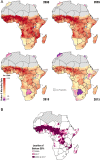Maintaining progress for the most beautiful chart in the world
- PMID: 31529108
- PMCID: PMC6748719
- DOI: 10.1093/inthealth/ihz046
Maintaining progress for the most beautiful chart in the world
Abstract
The decline in child mortality over the past two decades has been described as the greatest story in global public health. Indeed, using modern tools and interventions, there has been remarkable progress, reducing deaths in children <5 y of age by nearly half from 2000 to 2017. However, as a consequence of persistent geographic inequalities, we fall short of the United Nations Sustainable Development Goal to end all preventable child deaths by 2030, with an estimated 44.6 million preventable deaths expected to occur by the target year. This article discusses how we might further improve the downward trend in child mortality over the next decade to end preventable child deaths.
Keywords: child mortality; data visualization; global health; public health surveillance.
© The Author(s) 2019. Published by Oxford University Press on behalf of Royal Society of Tropical Medicine and Hygiene.
Figures



References
-
- Gates Notes 2017. annual letter. https://www.gatesnotes.com/2017-Annual-Letter (accessed 21 March 2019).
-
- Centers for Disease Control and Prevention Ten great public health achievements—worldwide, 2001. –2010. https://www.cdc.gov/mmwr/preview/mmwrhtml/mm6024a4.htm (accessed 29 April 2019).
Publication types
MeSH terms
LinkOut - more resources
Full Text Sources
Medical
Miscellaneous

